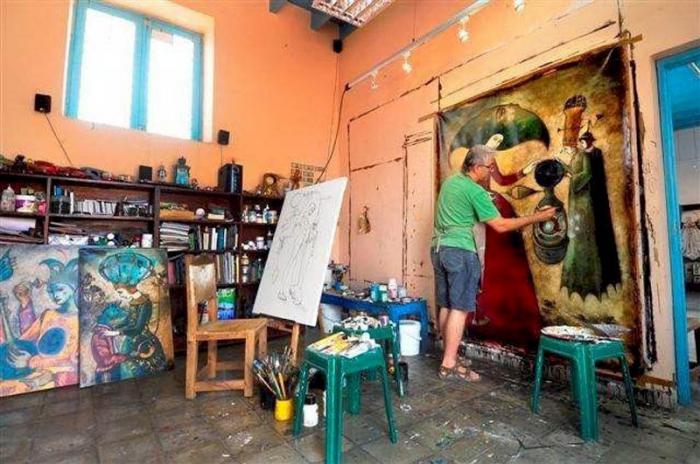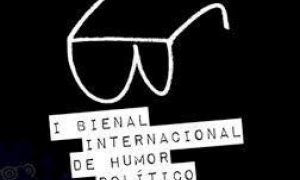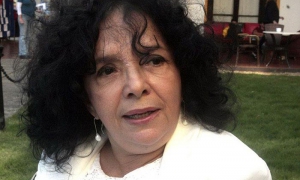
Certain critics place Carlos Guzmán (Havana 1970) in the category of post medieval, but to this artist with that restless spirit which influenced his development as a painter, sketcher, illustrator, sculptor and professor, definitions are of no concern.
This is what he emphatically stated in a brief conversation in the Carmen Montilla gallery, located near the Plaza de San Francisco de Asís in Old Havana, where Guzmán's exposition, Tiempo de Collage, is on display. "I leave the definitions to visual arts researchers; I do my work without worrying about whether they get it right or not." Graduating in 1989 from the San Alejandro Academy, he was "privileged to have excellent professors such as Flora Fong, Carlos del Toro, Eugenio D. Melón, Luis Reina and Antonio Alejo.”
Since 1988, Guzmán has participated in almost 100 personal and collective expositions, in Brazil; Mexico; Trinidad and Tobago; Guadalupe; Venezuela; Spain; the United States; Costa Rica; Puerto Rico; Slovakia; Panama; France; Russia and Holland.
The titles of his personal works are very suggestive. Some examples are: Mamá-Singer, Nemo y la ballena Rosa, Abracadabra, Seres de Luz, Zona de Silencio, Entre el Insomnio y la Espera, Viaje Astral, Ánima Interior and Maquinando Ilusiones. Given that this conversation took place in front of his work Tiempo de collage - sometimes under appreciated - we began with the show. "From the beginning I worked as much on collage as I did on painting. I always do, because it refreshes me. For me it is something complicated, it’s not something trivial.
You have to bring together many elements which you don’t even have at home, and suddenly you must make a story which has a common thread out of them; it’s not about putting objects together just for the sake of it, everything works together, it must be like the mechanism of a clock. It’s complicated, for me it’s very difficult.”
Your collages and painting both focus on the same themes? ”The central theme of my work is human beings, their connection with spaces of the universe, relationship with nature, such as artifacts, machines, inventions which have helped people, but can also be used against them.
I don’t offer a solution to these problems in my pieces, I don’t believe that’s my job, but I do present it in some way as a concern.” Certain influences from some of the greats of Cuban visual arts are evident… ”Yes, I reference the works of Antonia Eiriz, their strength and how she used recycled objects; Acosta León, his obsession with machines and Fidelio Ponce, his plaster work, and use of ochres. I take the work of all three as references and take from each one the elements which interest me most.” You mentioned the use of ochres, can you tell us a about your color pallet? “Something happens to me, I approach drawing differently to how I work with fabric.
I think that cardboard gives me more possibilities than fabric. Sometimes I have tried to create things which I have drawn and it doesn’t work and I have to approach it in a different way. I like to mix colors a lot and use them directly from the tube.
I work with primary colors, and often there are only three colors in the work, what happens is that by rubbing I create texture and these colors change.
Sepia is the most important in my work and sometimes I use it to give the impression of aging which transports to spectator to past eras.” Do you want to create a story in every picture? “I don’t know in every picture, but in a series, yes.
An idea suddenly comes to me, I immerse myself in it and try to develop it and the result is a group of pieces, on many occasions part of some concern I and others have, which you don’t even know how to begin the story you are developing.
I can tell you that it comes from deep inside, I don’t know if it’s a dream, the act of creation is complicated.” So you normally work in series? “Yes, I like to, because that way I am able to understand myself. I believe that the most important thing for an artist is that their work helps them to connect with themselves, to rediscover themselves.
I think this is one of the functions that painting and art can have. That’s how I see it. For me, it’s a way of developing myself as a human being.
Not just showing my art, earning money, but in some way the art I create also serves me as a human being.” Costume forms part of your creative work… “It is very important, it is an elaborate element which I incorporate as a feature of the character’s personality, and it gives them a place in the story.”
Objects are another resource of your language…. “Above all in collage, I use old records, book spines, clockworks, an infinite number of objects which form part of the history of humanity.” I read a review which stated that your work seems more European than Cuban… “Honestly, I feel very Cuban, and above all, very habanero and this is apparent in my work, although some people don’t see it. However, this doesn’t concern me: I paint what I want to represent.”
You are gaining international recognition… “I have been working internationally for a long time. There is interest in what is being created in Cuba, and to see it in Cuba.
Here there is a magic. I am working on a medium format exposition for Trinidad and Tobago which will be inaugurated on March 3, and another for Panama in April. The theme of the latter is similar to the exposition I took to Saint Petersburg last year (El elixir de la vida), featuring characters in the world of alchemy, of cooking.
A series which was a great pleasure to create, and now want to take up again. When do you decide you are ready to exhibit a work? Often when I have a group of pieces.
Other people invite you to expositions and they reserve a space for you, but there are times when I have said to myself that I am going to show something. This hasn’t happened often, only when I have made something which I believe is worth showing.
It’s not that I am satisfied, but that perhaps I have created something that the public, my friends and people who follow my work, should see. Carlos Guzmán works tirelessly in his studio, nestled between the streets Oficio and Obispo in Old Havana. There he transmits the inspiration which “comes from deep inside,” into new collages or installations. His creative world is very intense.






